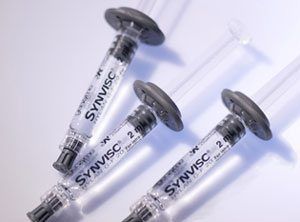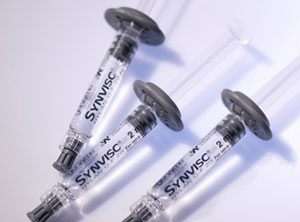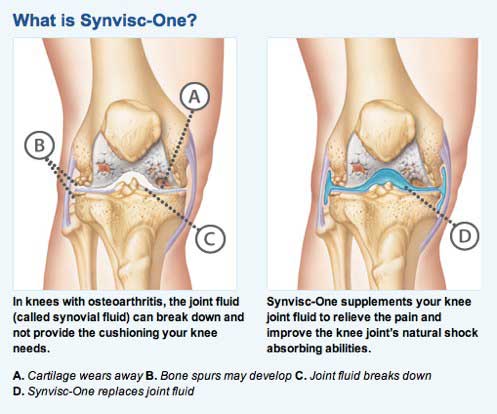 Viscosupplementation is becoming a popular treatment for knee arthritis. As rehabilitation and fitness specialists, it is important to have a clear understanding of what viscosupplementation is and what it means for our patients and clients that may be dealing with knee osteoarthritis. There are many options, benefits, and even side effects that we should be aware of.
Viscosupplementation is becoming a popular treatment for knee arthritis. As rehabilitation and fitness specialists, it is important to have a clear understanding of what viscosupplementation is and what it means for our patients and clients that may be dealing with knee osteoarthritis. There are many options, benefits, and even side effects that we should be aware of.
An Overview of Viscosupplementation for the Treatment of Knee Arthritis
Viscosupplementation is an intra-articular injection of hyaluronic acid into the knee joint by an physician. Hyaluronic acid (also known as hyaluron and hyaluronate) is a natural substance normally found in the synovial fluid of our joints. Its function is to act as a joint lubricant and shock absorber. It has been found that patients with knee arthritis have less hyaluronic acid in their joint.(1)
The theory behind the injections is that by injecting hyaluronic acid into the knee joint, the knee will have the necessary amount of hyaluronic acid and will also help the body stimulate production of more hyaluronic acid in the joint. This will improve patient symptoms of pain and allow for better functional mobility.
Here is an image from Genzyme, the makers of Synvisc, describing the benefit of viscosupplementation:
Viscosupplementation injections were first approved as a treatment for knee arthritis by the FDA in 1997. The important point to remember is these injections are a treatment, not a drug or a cure for arthritis. Hyaluronic acid injections, derived mostly from rooster combs, can provide several months of pain relief, and are given typically in a series of 3-5 injections. However, they do NOT provide any immediate effect on pain. Success is greater for patients with mild to moderate osteoarthritis. Viscosupplement injections can be repeated every 6 months if necessary.
Viscosupplementation Options
Currently, there are five approved viscosupplements known as the brand names Hyalgan, Synvisc, Orthovisc, Euflexxa, and Supartz. Each vary slightly:
- Hyalgan: First FDA approved viscosupplement; manufactured by Sanofi-Aventis; series of 3-5 injections at once per week; up to 6-7 months relief
- Synvisc: Manufactured by Genzyme; 3 injections a week apart; 6 month relief; now with SynviscOne, a single injection for 6 month relief
- Orthovisc: Manufactured by DePuy; Only viscosupplement not from an avian source; 4 injections with 6 month relief
- Euflexxa: Manufactured by Ferring Pharmaceuticals; 3 injections, 6 month relief
- Supartz: Manufactured by Smith & Nephew; 5 injections; Only viscosupplement approved to state it provides up to 12 months relief; also 3 injection series, providing 6 months relief (2)
Side Effects of Viscosupplementation
There are few side effects to these injections. Most often, there can be a local injection site reaction of redness and pain. A “hot knee” or a pseudo sepsis can also occur up to 72 hours after injection. NSAIDS, steroids, and/or arthrocentesis may be used to treat this. On a rare occasion, allergic reactions may occur. In general, this is a very safe treatment for knee arthritis.
Benefits of Viscosupplementation
A study done by Bannuru et al (3) published in 2009, compared hyaluronic acid injections to cortisone injections for treatment of painful knee OA. They found that after two weeks, the cortisone group had significantly less pain. At four weeks, both groups pain levels were the same. Finally at eight weeks, the hyaluronic acid group was significantly better than the group receiving cortisone. This is an important point to remember when patients ask about these injections. Viscosupplements can work well, but will NOT have an immediate result.
There are also studies comparing viscosupplements to saline injections (3) that have shown no difference between groups. Therefore, I tell my patients that there is a chance these injections may or may not help, but they are safe and may prolong the need for surgical intervention.
References
- Felson DT. An update on the pathogenesis and epidemiology of osteoarthritis. Radiol Clin North Am 2004; 42:1-9.
- www.hyalgan.com; www.synviscone.com; www.orthovisc.com; www.euflexxa.com; www.mykneeandme.com
- Bannuru et al. Therapeutic trajectory of hyaluronic acid versus corticosteroids in the treatment of knee osteoarthritis: A systematic review and meta-analysis. Arthritis Rheum 2009; Nov 30; 61 (12):1704-1711
- Lundsgaard et al. Intra-articular sodium hyaluronate 2 mL versus physiological saline 20 mL versus physiological saline 2 mL for painful knee osteoarthritis: a randomized clinical trial. Scand J Rheumatol. 2008 Mar-Apr;37(2):142-50.




 Trevor Winnegge Pt,DPT,MS,OCS,CSCS has been practicing PT for over 10 years. He graduated from Northeastern University with a bachelors in PT and a master of science degree. He also graduated from Temple University with a Doctor of physical therapy degree. He is a board certified specialist in orthopedics and also a certified strength and conditioning specialist. He is adjunct faculty at Northeastern University, teaching courses in orthopedics and differential diagnosis. He currently practices at Sturdy Orthopedics and Sports Medicine Associates in Attleboro MA, where he uses many of these pearls of wisdom regarding viscosupplementation for the treatment of knee arthritis.
Trevor Winnegge Pt,DPT,MS,OCS,CSCS has been practicing PT for over 10 years. He graduated from Northeastern University with a bachelors in PT and a master of science degree. He also graduated from Temple University with a Doctor of physical therapy degree. He is a board certified specialist in orthopedics and also a certified strength and conditioning specialist. He is adjunct faculty at Northeastern University, teaching courses in orthopedics and differential diagnosis. He currently practices at Sturdy Orthopedics and Sports Medicine Associates in Attleboro MA, where he uses many of these pearls of wisdom regarding viscosupplementation for the treatment of knee arthritis.

